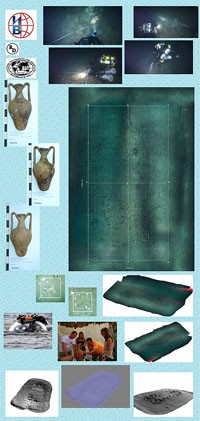Studies of a Byzantine ship of the X-XI centuries at Balaklava (Sevastopol, Crimea).
In the season 2015, the expedition of the Institute of Oriental studies with the supervisor, candidate of historical Sciences V. V. Lebedinsky and underwater club "Rostov-Dive" head R. G. Dunaev, with the support of the Russian geographical society and the Ministry of defence of the Russian Federation conducted research in the waters of the Crimean Peninsula from the towns of Sevastopol, Balaklava, Feodosiya, Sudak, Novy Svet. The research revealed a number of interesting and even unique underwater archaeological and historical monuments. The discovered objects cover various historical periods from the middle Ages to Modern times. The most modern equipment, including the sonar complex "Hydra", was used for carrying out research works.
One of the most interesting finds is a medieval Byzantine ship, dated, by the ceramic material, to the X-XI centuries. Most likely, it was a merchant ship, going from the coast of Asia Minor, probably from the area of Constantinople, to Cape Sarych, and then - to Kherson or medieval settlements located in the Western Crimea. The cargo of the ship consisted of amphorae, it was by them that we were able to date the find. Discovered amphorae, type 2 (according to the classification of Nergis Gunsenin), have a pear-shaped body with a smoothed surface, massive flattened in cross-section handles that are attached directly under the Corolla. The latter is represented by two variants: one in the form of a turn-down collar, the other-funnel. The potsherd is light brown, with lacunae of faded organic particles. On the walls and handles of these amphorae can be graffiti in the form of letters of the Greek alphabet and signs. This type of amphora is common in the Mediterranean and the black sea basin [Barnea, 1967, fig.161; Gunsenin, 1990, pl.XXXIII-XXXVI, type IIa,IIb; Hayes, 1992, type 60, p. 75, fig.26-4; Antonova et al. 1971, type XXI, Fig. 22; Jacobson, 1979, pp. 109-111; Parshina, 1991, pp. 76; Romanchuk et al. 1995, class 43, pp. 68-70, tab.34]. Most researchers attribute these amphorae to the second half of the XXI century [Nessel V. A. Ceramic complex / / Chersonesus collection.Supplement I. Topography Of Tauric Chersonesus. Catchment tank of a residential building in the quarter VII (IX-XI centuries). Sevastopol, 2006, pp. 97-98].
In amphorae, most likely, wine was transported, as in one of them the cork from a pine bark with a hole for removal of products of fermentation is found. At the site of the shipwreck, parts of the ship's structures are visible protruding from the ground in good preservation, which allows us to hope for significant fragments of the ship's hull preserved in the ground. These fragments of the vessel are of great interest, as they will help in the reconstruction of the shape and individual units of medieval ships.
The vessel is located at a depth of 83 m, in silty-sandy soil, which provided good safety of the object. The size of the upper, visible horizon of the monument (amphora spots) is - 27x14m. The uniqueness of this finding is also evidenced by the fact that only two ancient vessels of similar preservation were found in the Northern Black Sea region, but at great depths, which complicates their research.
On August 18, 2015, Russian President Vladimir Putin visited the research site.The wreck place is in need of state protection. At the moment, work is underway to put this unique object on the state register.






